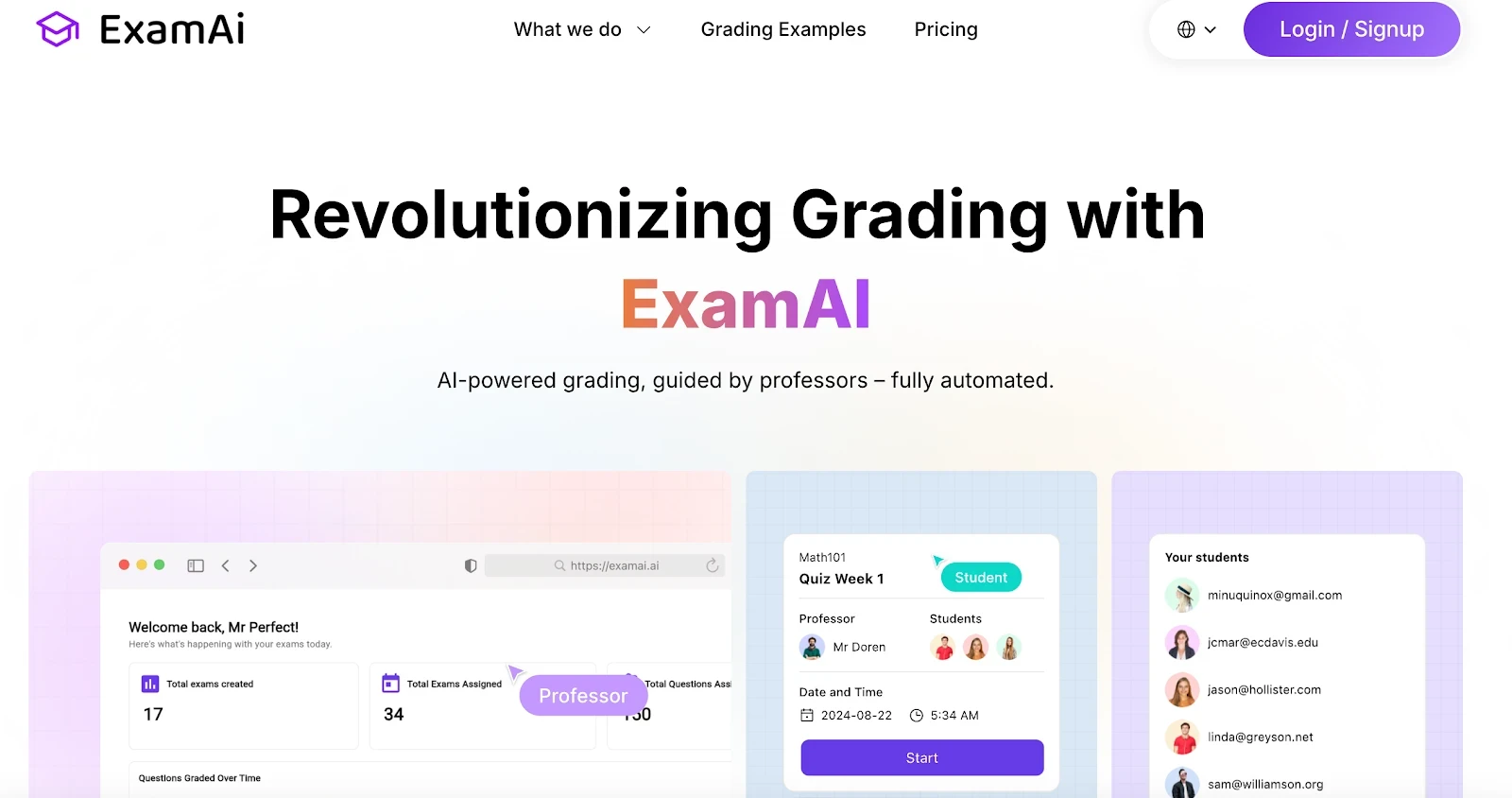Grading assignments can take up a lot of time for teachers, especially in large classes. AI grading tools can automate this process so educators can focus on improving the student's learning experience. These tools assess written assignments, exams, and other student work with speed and consistency.
This guide explains how AI grading tools work, their benefits, and features to look for. We’ll also review the top options available so you can find the best AI grading tool that works with your teaching strategies.
What Are AI Grading Tools?
AI grading tools are advanced systems that use artificial intelligence to evaluate and grade assignments, including essays, quizzes, and other written tasks. These tools assess key elements such as grammar, sentence structure, coherence, and relevance to the topic.
AI grading tools rely on technologies like natural language processing (NLP) and machine learning algorithms. These technologies are trained using large sets of sample essays to identify patterns in language and content. Once trained, the AI can analyze submissions and provide grades and feedback.
Benefits of AI Grading Tools
AI grading tools save time by automating the grading process. These tools ensure fair and consistent grading by applying the same criteria to every assignment, removing the risk of bias.
They also provide clear, actionable feedback, helping students identify areas for improvement, such as grammar or argument.
With near-instant results, students receive timely feedback, so they can revise their work. These advantages make AI essay graders an efficient and practical choice for educators.
5 Best AI Grading Tools for Teachers
AI grading tools have grown in popularity. They help educators handle assignments and assess student's writing skills. Below is an updated review of the top five AI tools for grading. These options cater to various classroom outputs, from essays to coding assignments.
Here are the 5 best AI grading tools for teachers and professors.
1. ExamAi
ExamAi is an AI platform that automates time-consuming tasks. It's the best AI grader for professors and students.
Other than grading assignments, the platform provides constructive feedback, tracks student performance, and highlights areas that need improvement. This AI grader works for essays, handwritten submissions, coding assignments, and more.
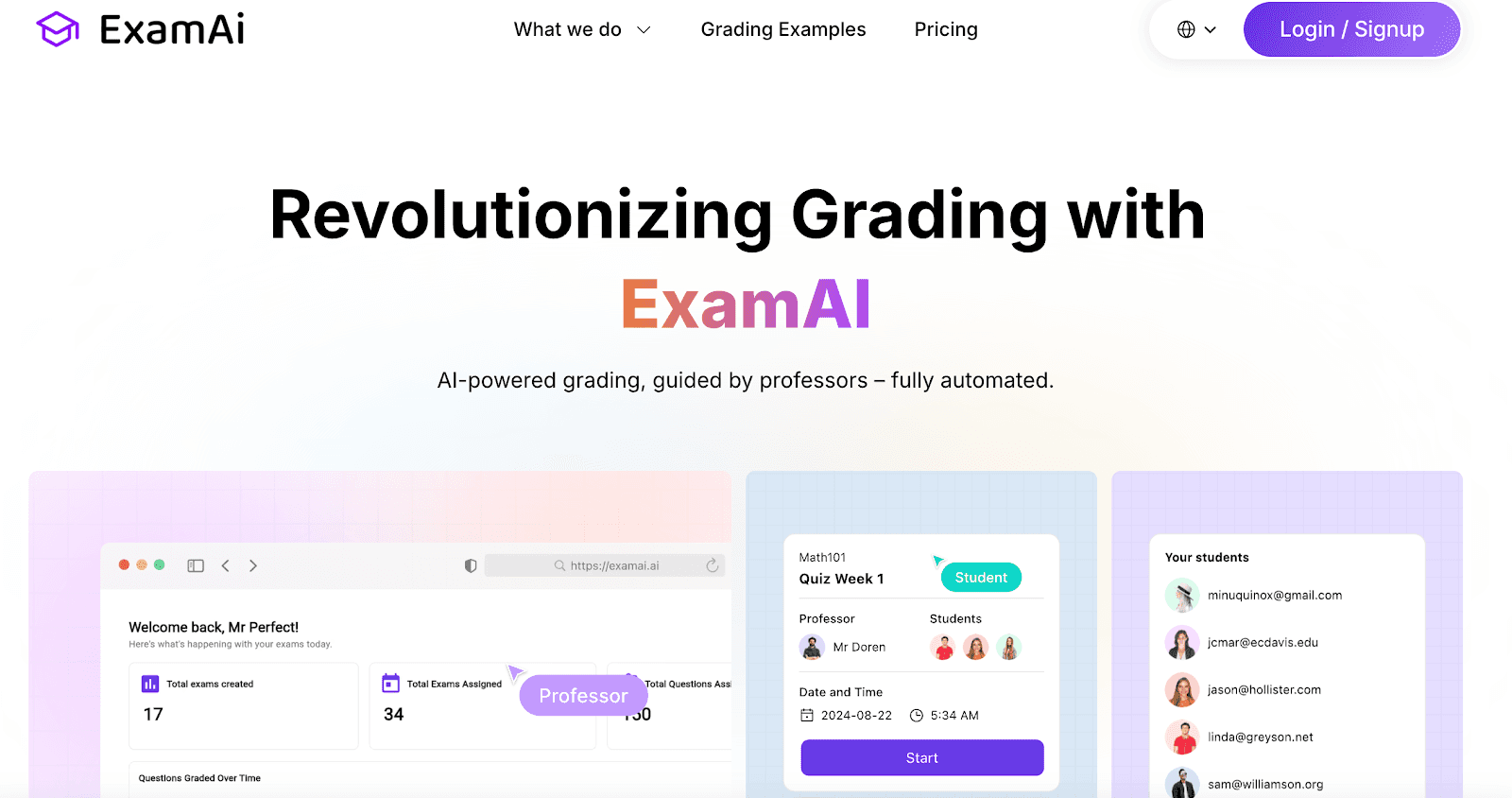
Key Features
Custom grading rubrics: Teachers can set clear grading criteria, ensuring assessments match their course goals.
Detailed analytics: The AI grader identifies trends in student performance, question difficulty, and overall grades.
Valuable feedback: Students receive step-by-step explanations of their mistakes and suggestions for improvement.
Multi-language support: Grades work in over 40 languages.
Large class compatibility: Handles grading for classrooms of any size, from small groups to large lecture halls.
Fair evaluations: AI removes personal bias and focuses entirely on the content of the submission.
Exam creation tools: Teachers can create exams using notes, previous tests, or customized questions.
Pricing
ExamAi offers flexible pricing plans to accommodate teachers, small classrooms, or large institutions:
Free plan: Grades 25 assignments per month with basic tools.
Premium plan ($20/month): Grades 150 assignments monthly with advanced analytics and personalized feedback.
Enterprise plan ($30/month per teacher): Offers unlimited grading with a custom school portal and full feature access.
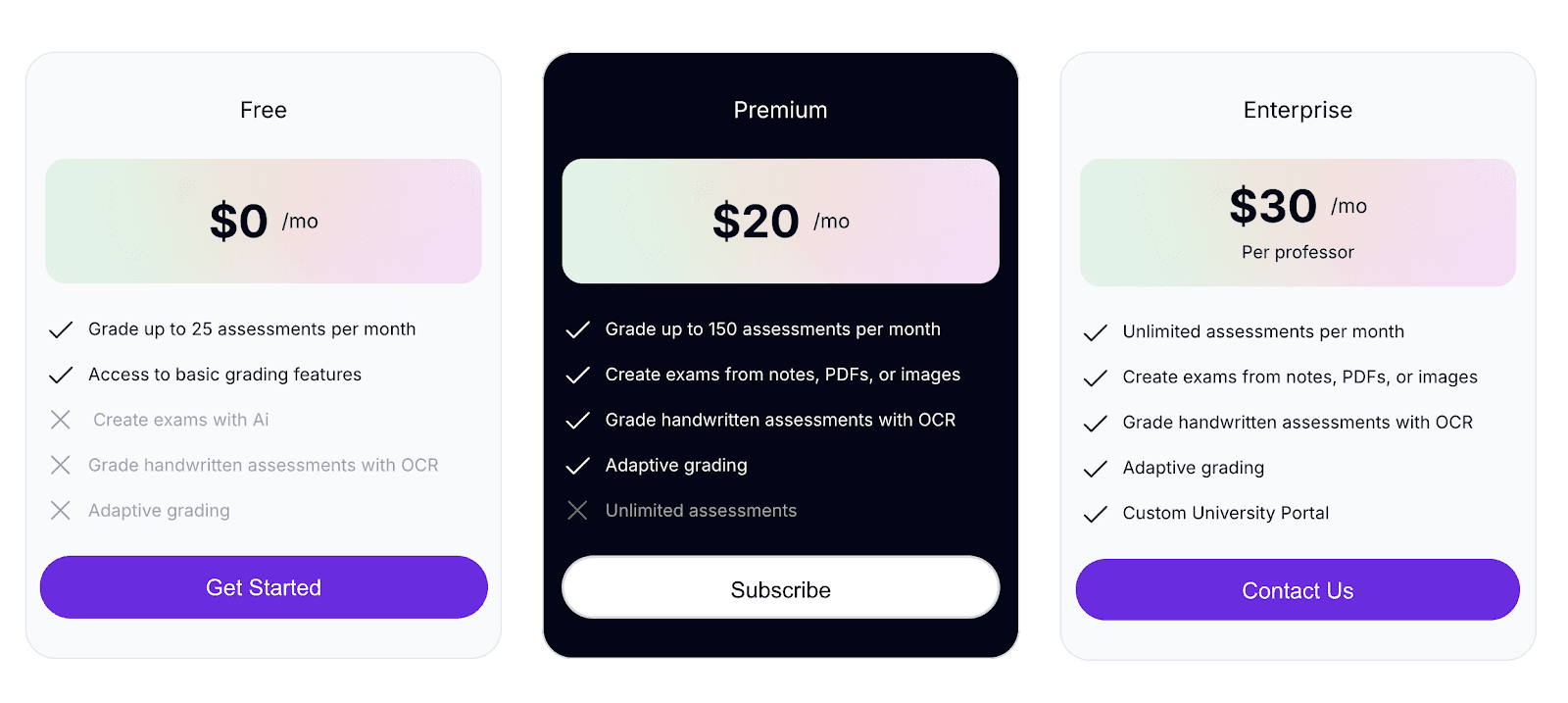
Pros
ExamAi automates grading for essays, coding tasks, and handwritten academic work. It identifies performance trends to help educators adjust their teaching strategies. Students also receive detailed feedback to improve their outputs.
Try ExamAi with a free plan and experience the time-saving benefits of an AI grader.
2. EssayGrader
EssayGrader uses AI to make grading essays faster and more organized. Teachers can create custom rubrics, review feedback reports, and handle large classes from a single platform. It connects with tools like Google Classroom and includes advanced features like detecting AI-generated content and summarizing essays.
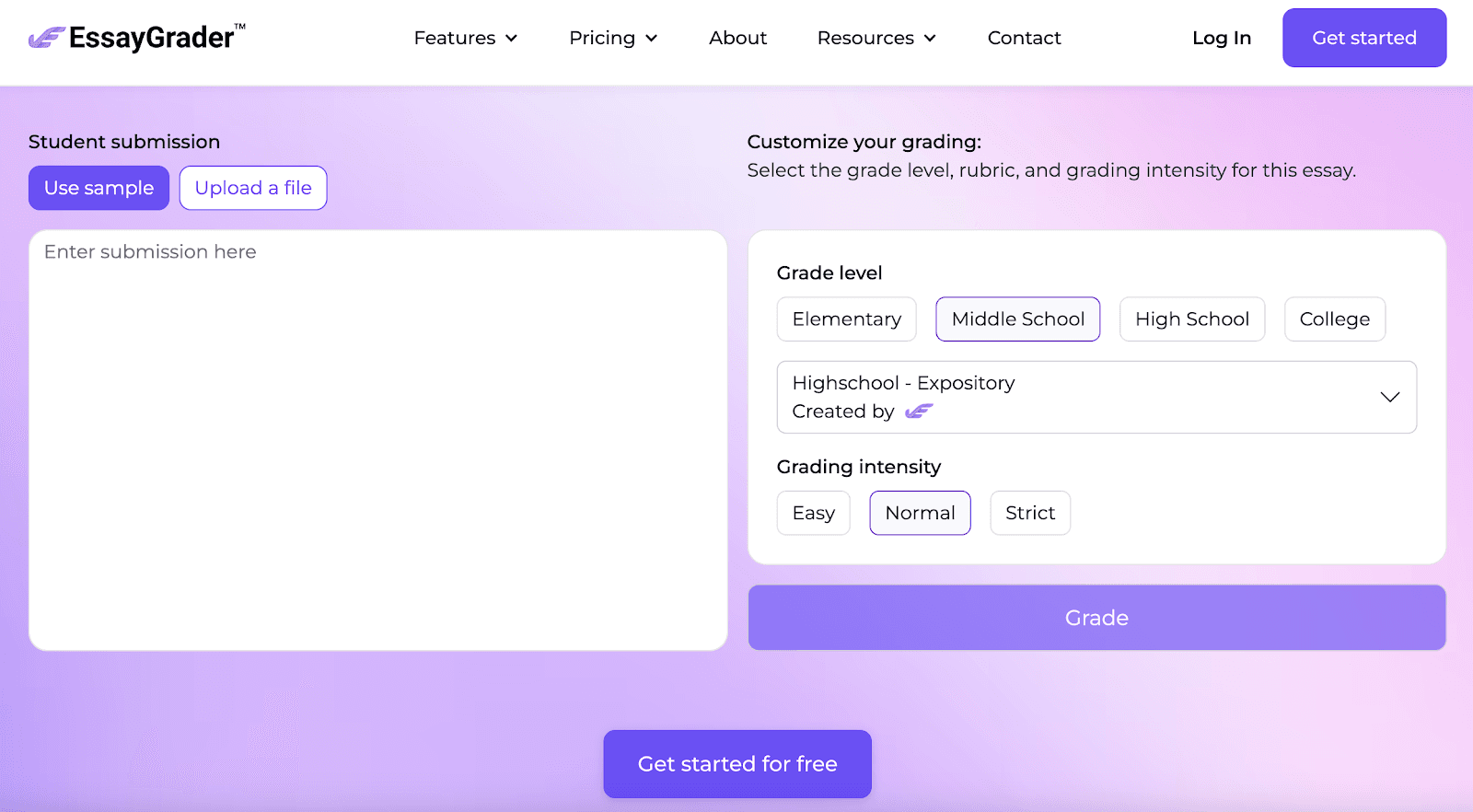
Source: Essaygrader.ai
Key Features
Class management: Organizes essays and grades within an easy-to-use platform.
Custom rubrics: Teachers can match grading criteria with course goals.
Default rubrics: Provides 16 ready-to-use rubrics for quick grading.
Bulk upload: Uploads an entire class’s essays in one step.
Feedback reports: Generates detailed comments on grammar, style, and content.
Centralized dashboard: Tracks submissions, monitors progress, and exports grades.
Google Classroom integration: Connects with Google Classroom for smoother workflows.
AI content detection: Identifies AI-written content in essays.
AI content summarizer: Provides concise summaries to speed up reviews.
Pricing
EssayGrader has pricing plans for teachers and institutions:
Basic (free): Grades up to 25 essays with a 1,000-word limit. Includes simple rubrics and basic integrations.
Lite ($8.99/month): Handles up to 100 essays per month (2,000-word limit). Adds Google Classroom and Canvas integration.
Pro ($19.99/month): Processes up to 350 essays monthly (3,500-word limit). Offers advanced rubrics, bulk uploads, and email support.
Premium ($49.99/month): Manages up to 800 essays with an 8,000-word limit. Adds chat support and full access to Pro features.
Institution plans: Start at $12.99 per user per month, including training and support options.
Pros
With EssayGrader, teachers can manage assignments for large classes and define grading criteria for different courses. It also provides detailed feedback on student essays.
Cons
The platform may overemphasize grammar and structure over creative or nuanced writing. Automated grading systems sometimes reflect biases in training data, which teachers should review during grading.
3. Gradescope
Gradescope is an assessment platform that helps teachers improve grading accuracy. It supports various assignment types, such as exams, bubble sheets, and programming tasks. By using AI to group similar responses and dynamic rubrics for flexible grading, Gradescope provides instant feedback on student performance.
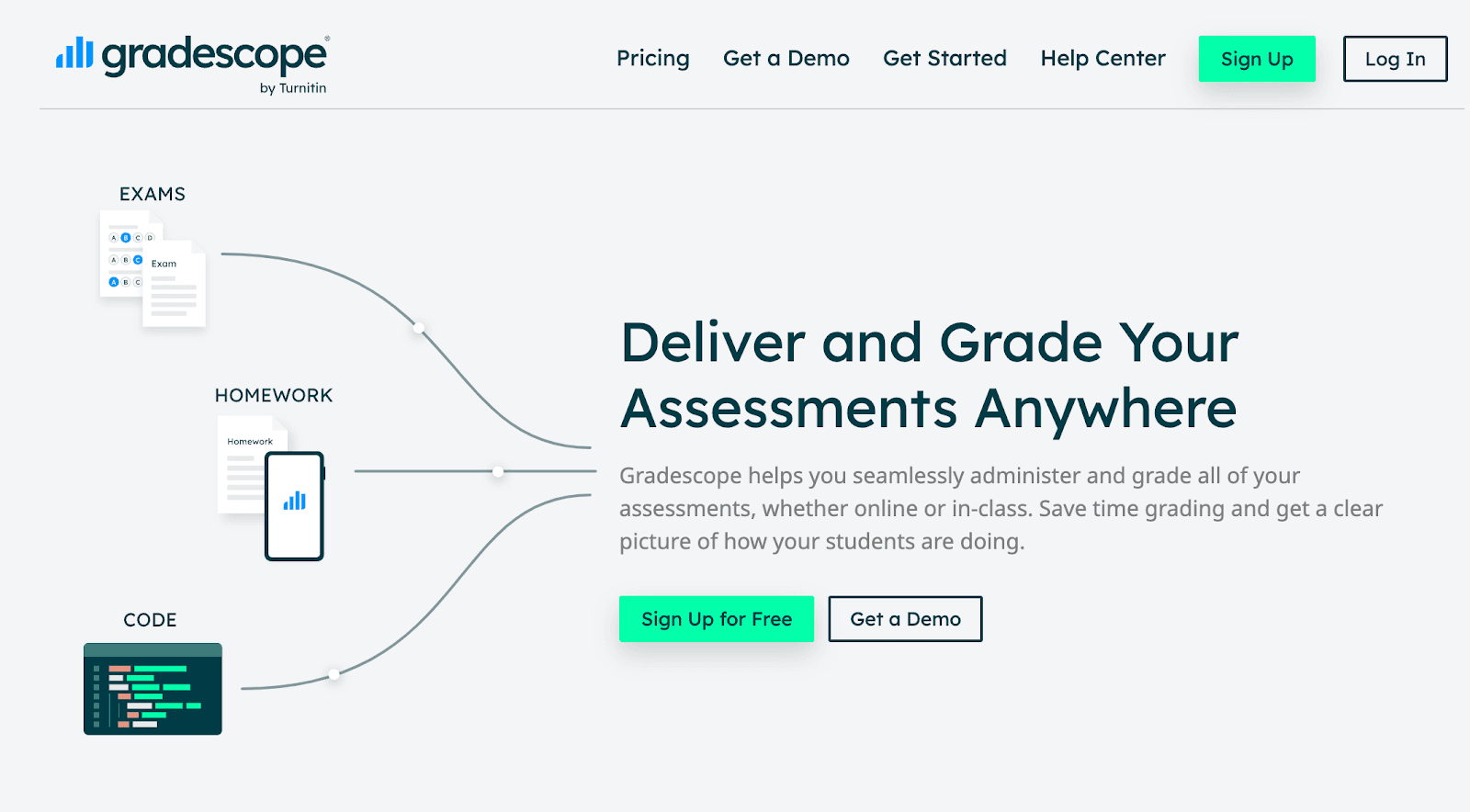
Source: Gradescope.com
Key Features
Dynamic rubrics: Adjust grading rubrics as you grade, maintaining consistency across submissions.
AI-assisted grading: Group similar answers using AI to grade student submissions.
Multiple assignment types: Handle written exams, bubble sheets, programming assignments, and homework.
Programming autograder: Automatically grade coding tasks in multiple programming languages with immediate feedback.
Detailed analytics: View question-specific performance data to identify trends and improve teaching methods.
Learning management system (LMS) integration: Sync grades, rosters, and assignments with learning management systems.
Pricing
Gradescope provides two pricing options. The Basic plan is free and includes core features like dynamic rubrics, question-by-question grading, and basic assignment support.
The Institutional plan offers advanced tools such as AI-powered grading, anonymous grading, a programming autograder, and LMS integration. However, pricing details are not publicly disclosed.
Pros
Gradescope supports various assignment formats, making it useful for different teaching methods. The platform’s detailed analytics help educators understand student learning processes and improve instruction.
Cons
Teachers may need time to familiarize themselves with the platform, especially when using advanced features. Access to AI-assisted grading and other premium tools requires subscribing to the institutional plan, which is not available to individual users.
4. Kangaroos AI
Kangaroos AI automates grading and other teaching tasks. It's not only an AI grader, the platform also generates lesson plans and creates grading rubrics. This AI grading tool is suited for teachers managing multiple responsibilities and large classrooms.

Source: Kangaroos.ai
Key Features
AI essay grader: Grades essays automatically and provides constructive feedback.
Customizable rubrics: Supports uploading personalized rubrics aligned with curriculum standards.
Bulk upload: Processes and grades multiple essays simultaneously.
AI lesson plan generator: Creates structured lesson plans based on different subjects.
AI rubric generator: Develop detailed grading rubrics for consistent evaluations.
AI short answer grader: Assesses short responses with high accuracy and instant feedback.
Pricing
Kangaroos AI offers a free plan that includes tools like the AI essay grader. However, pricing details for premium features are not disclosed publicly.
Pros
The AI grader’s bulk upload feature handles high volumes of assignments, making it practical for larger classes. The AI essay grader also enhances feedback quality for student essays. Additional tools like the AI lesson plan generator help teachers organize their teaching.
Cons
The platform depends on digital submissions, which may not always be feasible. Some teachers may need time to familiarize themselves with its features. Relying too much on AI for assessments might risk missing deeper aspects of student performance, such as creativity or critical thinking.
5. CoGrader
CoGrader uses AI to grade essays and assignments. It automates feedback generation and grading suggestions, helping teachers handle large volumes of work efficiently.
The platform includes tools for creating rubrics, detecting plagiarism, and analyzing class performance. CoGrader also integrates with platforms like Google Classroom.
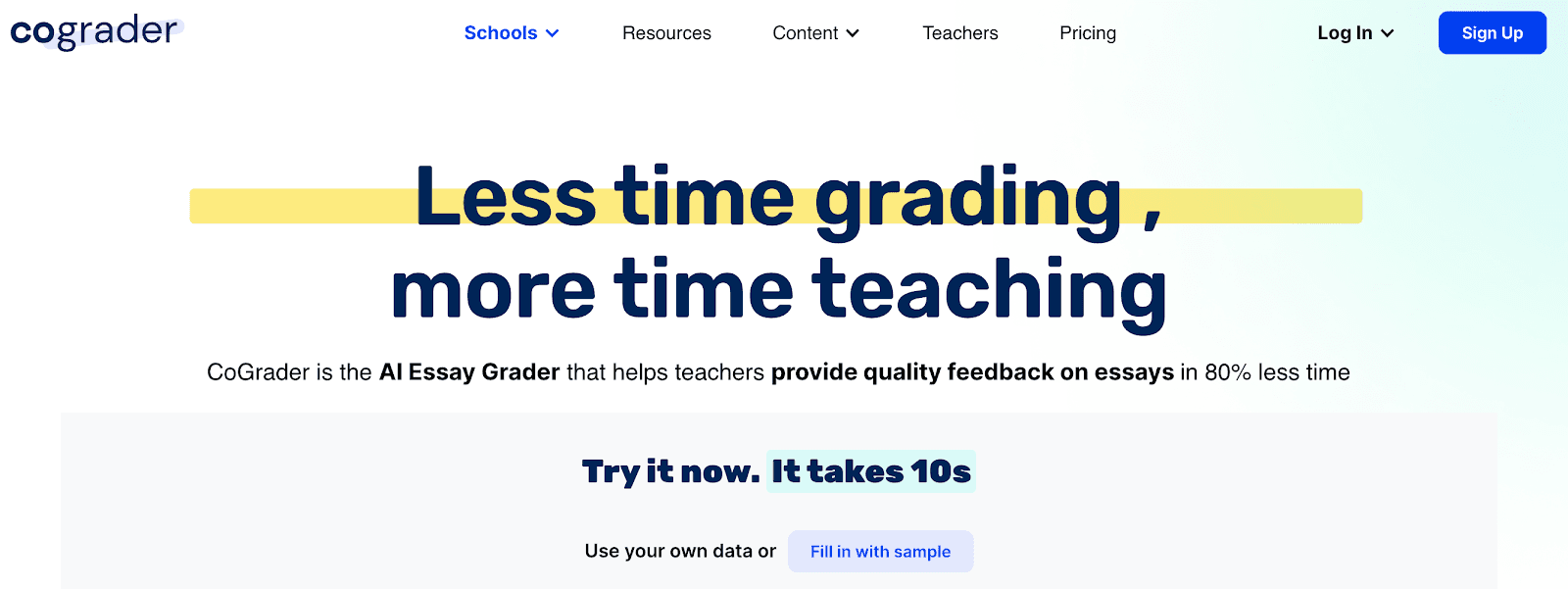
Source: Cograder.com
Key Features
AI-driven grading: Automates grading by generating feedback and grade suggestions for student essays.
Customizable rubrics: Allows teachers to create and use rubrics that match specific grading standards.
LMS integration: Connects with Google Classroom to import and export assignments.
Class analytics: Tracks student performance trends and provides meaningful feedback.
AI and plagiarism detection. Identifies AI-generated text and plagiarism to maintain academic integrity
Pricing
CoGrader pricing plans include:
Starter (free): Grades up to 100 submissions and includes Google Classroom integration and rubric creation tools.
Standard ($19/month): Grades up to 300 submissions per month and adds grammar checking, customizable rubrics, and a class dashboard.
Schools and districts (custom quote): Includes unlimited submissions, integrations with Canvas and Schoology, shared rubrics, admin controls, and institution-wide reporting.
Higher Ed and enterprise (custom quote): Offers all features, plus API access, account management, custom LMS integrations, advanced analytics, and support with service-level agreements.
Pros
The platform supports collaboration with shared rubrics and integrates with Google Classroom for better organization.
Cons
The system relies heavily on LMS integration, which may not suit schools without compatible platforms. Customizable rubrics, while flexible, may not fully address niche grading requirements in some courses.
Features to Consider When Choosing an AI Grading Tool
Educators need to evaluate AI grading tools and make sure they align with their teaching methods. Here are the features to prioritize when making your decision:
Assignment Compatibility
Check if the tool supports various assignment types, such as essays, multiple-choice questions, coding tasks, and short answers. A tool that handles diverse formats is ideal for meeting different teaching demands.
Scalability for Class Size
Make certain the tool can handle your class size, whether it’s a small group or a large lecture hall. A scalable tool prevents limitations as your needs grow.
Customization Rubrics
Look for tools that let you create and adapt grading rubrics based on your course requirements. This flexibility helps maintain grading standards and consistency.
Integration With Learning Platforms
Choose tools that connect with systems like Google Classroom or Canvas. These integrations streamline assignment uploads, grading workflows, and grade management.
Pricing
Compare the costs of various tools, considering free plans for basic needs or premium tiers that offer advanced features like analytics, integrations, and larger submission capacities.
Use ExamAi—The Best AI Grading Tool for Teachers
If you're looking for an all-around AI grading tool, ExamAi is a great option. It works well for different class sizes and supports multiple languages.
ExamAi uses advanced technology and simple tools to make grading easier. It automates repetitive tasks and gives useful insights, so you can spend more time teaching and less time on paperwork.
Start with the free plan today!
FAQs About The Best AI Grading Tool
Which AI is best for grading?
ExamAi is the best overall AI grading tool. The platform provides customizable rubrics, detailed analytics, and support for diverse assignments.
What is the best AI tool for analyzing student performance?
ExamAi’s data analytics portal provides detailed insights into student performance, helping professors identify challenging questions and improve learning outcomes.
Can I use AI to grade?
Yes, AI tools like ExamAi automate grading for essays, coding tasks, and multiple-choice assignments.
Can AI help me create quizzes?
Absolutely. ExamAi allows professors to create quizzes, exams, or homework instantly by uploading notes or past exams in one click.

